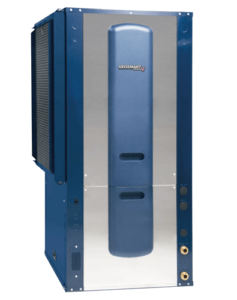
How Geothermal Heat Pumps Work
Throughout the year, almost 50% of the sun’s energy is absorbed into the earth where it maintains a consistent temperature of 10°C to 16 °C a few feet below the ground’s surface. Geothermal technology harnesses the temperatures below the surface of the earth to heat and cool structures by combining a series of loops installed outside underground with a heat pump system inside.
This combination of high performance technology allows us to tap into the earth’s natural heating and cooling properties to consistently and evenly distribute warm or cool air in your home or office throughout each season.
An environmentally friendly antifreeze solution or pure water carries energy directly from the closed or open loop system into the heat pump inside your home or office. In the winter, the heat pump acts as a furnace, distributing the heat throughout your home using the system’s heat exchanger and compressor. In the summer, it acts as an air conditioner, collecting the heat from your home and distributing it into your domestic hot water tank or back into the earth through the loop system.
Not only can a geothermal system provide you with year round indoor comfort, it can also provide inexpensive domestic hot water, supplementing or replacing your conventional domestic hot water heater.
Whether you live in the country or city, there is a geothermal solution that will work for every building type and every climate condition.
Why Choose a Geothermal Heat Pump System?
- They last longer than traditional heat pumps: Geothermal Heat Pumps last longer than traditional heat pumps because they are not exposed to the outdoor elements.
- Highly Efficient, No Carbon Emissions:
Winter - Through a highly efficient process, heat is extracted from the earth, and used to heat the home. The system is self-contained and produces no carbon emissions.
Summer - The home is cooled by the extraction of heat from the home and transferring it into the ground, with even greater efficiency, using the same equipment.
- Savings: Homes that heat with oil, propane, and natural gas, and larger homes will notice significant savings upon installation of a geothermal system. The chart below shows the average reallocation of heating and cooling loads after conversion to a geothermal system.
Geothermal systems provide 75% savings over traditional heating systems, and add up to 40% savings on hot water costs.
INSTALLATION:
Geothermal systems consist of a heat pump unit installed in the home tied to your duct system, and a loop system created by a series of pipes buried underground on your property.
Our skilled geothermal specialists will determine the geothermal loop system that is best suited for your home or business.
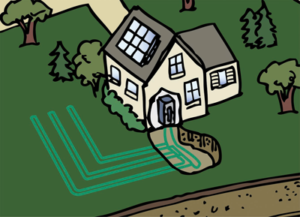
Horizontal Loops
Horizontal loops require the most land space, and are commonly used in rural areas. Using excavators, trenches are dug about six feet deep into the ground, each one up to 300 feet long. Geothermal pipes are then placed in the trenches and backfilled with soil.
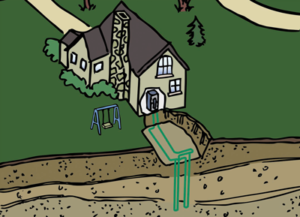
Vertical Loop
Vertical loops require less land space for installation making them ideal for urban areas. Vertical holes are drilled into the ground each ranging from 180 to 540 feet deep by using specially designed geothermal drilling rig bores. Geothermal pipes are then inserted into the vertical bores, then filled with bentonite grout.
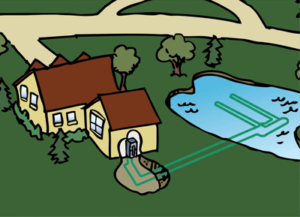
Pond or Lake Loop
Properties with a nearby lake or pond that is appropriate in size and depth (8ft), can have a loop system submerged at the bottom of the body of water. A single trench is excavated from the home to the body of water and typically two pipes are inserted into it. The two pipes connect to several geothermal pipes that are submerged at the bottom of the lake or pond.
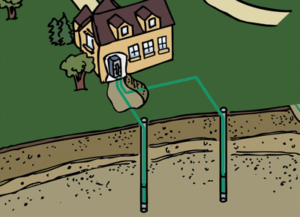
Open Loop
Open loops can be used on properties where existing high capacity water wells are available. Water from the aquifer is withdrawn through a supply well and pumped into the heat pump, and the discharged water from the heat pump is redirected into the second well back into the same aquifer.
Frequently Asked Questions:
Geothermal heating is a large investment, a ball park pricing for installation in an average home (2000 sq. ft.) could cost $30,000 to have installed. With a monthly saving of 50% on your heating bill.
Returns on investment are realized on larger projects, buildings, and homes where power consumption is considerably higher. For larger buildings and homes, a geothermal heating system can pay for itself in 6 – 8 years.
As a general rule, unless you spend more than $5000 a year on heating, you may be better off investing the same amount of money in improving your thermal envelope by increasing the insulation of your home instead.
The indoor component of the geothermal system (heat pump unit) generally lasts 20 – 25 years (conventional furnace lifespans are 15 years or less). The outdoor infrastructure of the the geothermal system (ground loop) life expectancy is 25 – 50 years.
Request a Free Quote Today
Is Geothermal Heating right for you? Contact Freddy Beach Heating today, and we will help you find the best heating and cooling options available for your home or commercial space.
